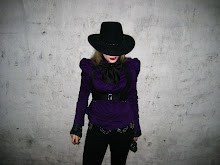Dazzling to the eye with a dark, fecund mystery that's laced with myth and history, 'vamp' is omnipresent in contemporary culture. As an aesthetic edifice it bleeds into fashion and film. There are the iconic sartorial designs that have influenced our understanding of the vamp look, and there are the femme fatales onscreen, who embody the concept with image and action. "A sensibility (as distinct from an idea) is one of the hardest things to talk about," writes Susan Sontag in "Notes on 'Camp.'" Vamp, like camp, with its shrouded origins and multivocal meanings, is no different.

The term seems to have entered the popular milieu with silent screen star Theda Bara's 1915 film,
A Fool There Was. It's a tale of the seduction and corruption of a Wall Street lawyer by a woman credited ominously as "The Vampire." Not an undead beauty, Bara plays a psychic vampire, feeding on weakness and destroying with her sex. With dark painted eyes and a sly smirk she crushes rose petals in her hands, and with her wiles, leads her lover to the gutter. She earned the nickname "the vamp" in the American public from that point on, cementing the slang for predatory females.
From the outset, vamp is a gendered term. (Paraphrasing Sontag: to (v)amp is a mode of seduction.) In one connotation, vamping is a stylized sexualized performance that invokes a looming sense of foreboding. It is in many ways an aestheticized interpretation of how straight men have approached the fairer sex for millennia - desire mingled with fear, agony accompanied by ecstasy. Another reading might reveal the destructive misogyny that turns the virtue of a sexually empowered woman into a vice. (She is only riding the pleasure principle into its inevitable outcome, feminists could argue.) Either way, we fear what we cannot control, regardless of the vamp’s true intentions.
As a teenager, my brother would comment on my short nails painted dark red, calling them "vamp." He had dabbled in NYC's hedonistic club scene of the mid-80s and so I romanticized this use of the term, hoping there was a whole cult of vamp I could enter upon moving to the city. While no such thing happened, I have been drawn to the idea of vamp ever since. There must have been something to what he said though, because Chanel came out with a dark red and black nail polish line in 1994 with that very title.


Recently, the word appeared in Lady Gaga's song "Teeth" from 2009's
The Fame Monster. She sings "Don't need direction...Just got my vamp" as the synth groove vamps beneath: surely a vamp collision if I've ever heard one. Then there was the lesser known glam metal band Bang Tango's 1991 track, "Dressed Up Vamp," which has Joe Leste crooning "dressed up vamp tonight...looking for love and a lonely bite," referencing the bloodsucking side of the spectrum whilst injecting a masculine edge to the vamp sensibility. And I’d be remiss not to mention the ladies in “Addicted to Love” as vamp incarnate.
Quite a mercurial little phenom.
Along with these uses, there are other meanings, too. In dictionary English to vamp is to patch up or piece something together. It is to concoct or invent. Like camp, vamp has its performative aspects, but there is no wink to betray the performance. Vamp does not deal in irony: it is dead serious.
Perhaps most importantly, there are the musical implications of vamp. A vamp is the ostinato of popular music, and the sounds of a vamp in musical theatre or jazz can often evoke the qualities of the abovementioned vamp: a sultry slink, a wanton strut. As a sonic structure it provides the musical meat of the performative aural arts. The vamp can be itself an introduction to a vamp: just take in any moment of Cabaret, Chicago or Sweeney Todd to see this put into practice. And while there's often musical improvisation over one, the vamp itself is musically spare, open to variation, and keeps a repeated rhythm. The visual vamp is much the same way.

The vamp look is never overdone. In fact, it is the understated fashion of a vamp that makes her stand out so severely. The red lips, the impeccably tailored outfit, the silk stockings, the spike heels. It’s akin to imagery found in Coco Chanel, Victorian mourning attire, and in the work of recent greats like Helmut Lang, Thierry Mugler, Rick Owens, and Gareth Pugh. From Theda Bara to Bettie Page and Morticia Adams to Angelina Jolie, the vamp look has changed dramatically. Nonetheless, it retains a stark aesthetic, open to change, with a repetition of the risque.
The sensibility of vamp has invaded popular culture, grasping at all of the arts with its shadowy fingers. Now more than ever, as the word 'vampire' is so laden with immaturity and sexual abstinence, the more erotic and esoteric term 'vamp' may finally have it's day. What that fully means, however, I can't quite say...





.jpg)




















































